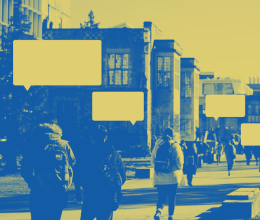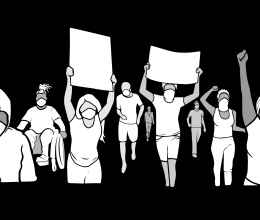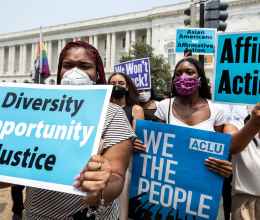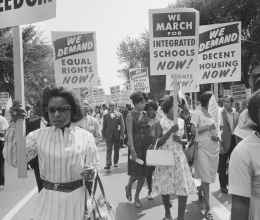
Police body-worn cameras are a subject about which many people have differing intuitions. Some activists tell us they worry we are mistaken in conditionally supporting the technology; that it will become a tool for increasingly police power, but not oversight. Others point to situations in which the cameras have been crucial in bringing justice—or at least in exposing injustice. In light of such debates, the troubled police department in Albuquerque provides an interesting case study.
The Albuquerque department has been the subject of a Justice Department investigation, which found in a damning report that "Albuquerque police officers often use deadly force in circumstances where there is no imminent threat of death or serious bodily harm to officers or others," and often used unnecessary less-than-lethal force "without regard for the subject’s safety or the level of threat encountered." At the same time, the Albuquerque police department actually uses body cameras, which were adopted in 2012 in the wake of controversy over police shootings, along with a requirement that officers use them to document civilian encounters.
However, the cameras have hardly proven to be a solution to the department's problems.
The ACLU of New Mexico has been leading the way in pushing for reform of the Albuquerque police department, with its advocacy having for example played a key role in prompting the Justice Department's investigation. I spoke recently with Legal Director Alexandra Smith about what's happening with the cameras in Albuquerque, and she outlined the situation for me:
It’s important to understand how serious a problem the Albuquerque Police Department has had with officer shootings. In the past five years, over 40 people have been shot by police and two-thirds of these shootings have been fatal. The rate of police shootings here is 4 per 100,000 people—that’s ten times higher than the rate in New York City. This is particularly alarming because violent crime and assaults against officers have been declining for years.
In Albuquerque the police have body worn cameras available in the police department and they have rules in place where they’re supposed to use them. But they’ve been used sporadically—police use cameras when it suits them, and they don’t when it doesn’t. The selective recording that goes on in these police misconduct cases has been a real problem for us.
There have been police shootings where the cameras simply weren’t turned on. There was one case—Christopher Torres—where police shot an unarmed man in the back, in his back yard, while he was in his pajamas. In that case, they simply didn’t turn the footage in. And that was just valid and acceptable to them.
And there was the case of Mary Hawkes, a 19-year-old unarmed girl who was shot in back by a police officer, who didn’t turn on the camera in that case.
And there are many many cases like this, where the cameras simply weren’t turned on, or the officers said they weren’t turned on, or the footage wasn’t turned in. But of course in criminal cases, when the footage is good for them, they'll use that footage.
People try to make the point, “oh look at Albuquerque, they have cameras but it’s not working for them.” But it’s because the police don’t use them. Just having the cameras isn’t enough: policies need to be enforced. If officers actually knew they were going to face strict sanctions for not using their cameras, I think it would be a very different picture. Right now in Albuquerque they face NO consequences for it. Just a couple months ago, an officer was finally disciplined for not using his camera after he failed to use it FIVE different times—and it was the same officer who shot Mary Hawkes, and didn’t use his camera in that incident. He was finally disciplined, but that was the first time that we’d seen that.
I asked Smith about the notorious James Boyd killing, in which a mentally ill homeless man with a knife was shot in the back by officers standing at least 10 feet away. In that case, body camera footage of the shooting WAS released—and sparked outrage, nationwide press coverage, and large protests in Albuquerque. But even in that case, Smith said, the footage appears to have only been released because the department thought it would help them:
Right after he was shot, the police department actually released the footage, and the police chief made a statement right away and said “There was no misconduct here.” The police had been under fire for all these shootings, and I think they really thought it was a justified shooting. When there was such an outcry about it, I think they were surprised that people saw it differently. Because if they thought it was bad, they would have refused to release the tape, like the do in most cases
Right now there is a proposed consent decree between the Justice Department and the city. We’ve moved to intervene in that case. If we’re able to intervene then we’ll advocate for strict sanctions when it comes to the cameras—that they need to be used consistently, that the tape needs to be turned in, and they check that everything is working, that it needs to be audited. And for officers who violate the policy, and aren’t turning it on when they should, that there be tough sanctions—suspension on first violation, and termination on a second.
We should always be concerned about the privacy implications of cameras, and minimize those. But when you have a situation where police really are killing people, and hiding the tape, or deciding not to record, and you have a RAMPANT problem, like we have here, having oversight is important, and the cameras are the best oversight we have. The Boyd case is a very good example of where having the camera makes a huge difference. If they’d never released that footage, this case would have been nothing. It would have just been a case where police said “a homeless camper pulled knives out and we had to shoot,” and nobody would understand what it really looked like.
In the end, the Albuquerque experience shows just how badly body-camera oversight is needed. At the same time, it appears to be an example that confirms the worst fears of those who oppose the cameras—that, as Smith says, they'll only be used by the police when and how "it suits them." But we shouldn't reject cameras based on fear of Albuquerque's failures. The real takeaway should be that no matter what a police department's camera policies may be on paper, those policies actually need to be strictly enforced. And there's absolutely no reason every department in the nation can't do that and ensure that officers never feel they have leeway to evade the oversight a rolling camera provides.







